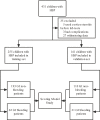Construction and internal validation of a predictive model for risk of gastrointestinal bleeding in children with abdominal Henoch-Schönlein purpura: A single-center retrospective case-control study
- PMID: 36248897
- PMCID: PMC9556720
- DOI: 10.3389/fimmu.2022.1025335
Construction and internal validation of a predictive model for risk of gastrointestinal bleeding in children with abdominal Henoch-Schönlein purpura: A single-center retrospective case-control study
Abstract
Early identification of gastrointestinal (GI) bleeding in children with abdominal Henoch-Schönlein purpura (HSP) is essential for their subsequent treatment, and a risk prediction model for GI bleeding in abdominal HSP was constructed in this study to assist physicians in their decision-making. In a single-center retrospective study, the children collected were divided into two parts, a training set and a validation set, according to the time of admission. In the training set, univariate analysis was performed to compare demographic data and laboratory tests between the two groups of children with GI and non-GI bleeding, and the independent risk factors were derived using binary logistic equations to develop a scoring model for predicting GI bleeding in children by odds ratio (OR) values and receiver operating characteristic curves. The scoring model was then internally validated in validation set. The results showed that there were 11 indicators were statistically different between the two groups in the training set, including white blood cells, neutrophil-to-lymphocyte ratio, platelets, eosinophils (EO), high sensitivity C-reactive protein (hsCRP), activated partial thromboplastin time (APTT), sodium, potassium (K), albumin (ALB), Total bilirubin, and Immunoglobulin E (IgE) in the univariate analysis. Among them, the independent risk factors for GI bleeding included the six indicators of EO ≤ 0.045×10^9/L, hsCRP ≥ 14.5 mg/L, APTT ≤ 28.1 s, K ≥ 4.18 mmol/L, ALB ≤ 40.6 g/L, and IgE ≥ 136 ng/mL. According to the OR values, where EO ≤ 0.045 ×10^9/L, hsCRP ≥ 14.5 mg/L, APTT ≤ 28.1 s, ALB ≤ 40.6 g/L each scored 3 points, K ≥ 4.18 mmol/L, IgE ≥ 136 ng/mL each scored 2 points, and the total score was 0-16 points. The sensitivity and specificity of predicting GI bleeding were 88.7% and 64.2%, respectively, when the child scored ≥ 7 points. In the validation set, the sensitivity, specificity and accuracy of the model in predicting GI bleeding were 77.4%, 74.5% and 75.2%, respectively. In conclusion, the construction of a scoring model to predict the risk of GI bleeding from abdominal HSP would greatly assist pediatricians in predicting and identifying children at high risk for GI bleeding at an early stage.
Keywords: Henoch-Schönlein purpura; IgA vasculitis; binary logistic regression; gastrointestinal bleeding; gastrointestinal involvement; predictive scoring model.
Copyright © 2022 Sun, Liu, Li, Zhang and Shi.
Conflict of interest statement
The authors declare that the research was conducted in the absence of any commercial or financial relationships that could be construed as a potential conflict of interest.
Figures


Similar articles
-
Gastrointestinal bleeding in children with Henoch-Schönlein purpura combined with prognostic nutrition index may predict endoscopic duodenal ulcers during hospitalization: A single-center retrospective case-control study.Medicine (Baltimore). 2024 May 31;103(22):e38321. doi: 10.1097/MD.0000000000038321. Medicine (Baltimore). 2024. PMID: 39259119 Free PMC article.
-
Clinical analysis of 99 children with Henoch-Schönlein purpura complicated with overt gastrointestinal bleeding.Clin Rheumatol. 2022 Dec;41(12):3783-3790. doi: 10.1007/s10067-022-06323-8. Epub 2022 Aug 8. Clin Rheumatol. 2022. PMID: 35941339
-
Neutrophil-to-lymphocyte ratio to predict gastrointestinal bleeding in Henoch: Schönlein purpura.Pediatr Int. 2018 Sep;60(9):791-795. doi: 10.1111/ped.13652. Epub 2018 Sep 5. Pediatr Int. 2018. PMID: 29947449
-
Clinical relevance of neutrophil-to-lymphocyte ratio and mean platelet volume in pediatric Henoch-Schonlein Purpura: a meta-analysis.Bioengineered. 2021 Dec;12(1):286-295. doi: 10.1080/21655979.2020.1865607. Bioengineered. 2021. PMID: 33412982 Free PMC article.
-
Henoch-Schönlein Purpura in Children: An Updated Review.Curr Pediatr Rev. 2020;16(4):265-276. doi: 10.2174/1573396316666200508104708. Curr Pediatr Rev. 2020. PMID: 32384035 Review.
Cited by
-
Analysis of the influencing factors of abdominal Henoch-Schonlein purpura in children with gastrointestinal bleeding and the clinical value of PLR.Am J Transl Res. 2024 Aug 15;16(8):3867-3874. doi: 10.62347/NNRB3322. eCollection 2024. Am J Transl Res. 2024. PMID: 39262691 Free PMC article.
-
Possible Threats of IgA Vasculitis in Children: One Center Experience.Acta Med Litu. 2024;31(2):254-263. doi: 10.15388/Amed.2024.31.2.4. Epub 2024 Dec 4. Acta Med Litu. 2024. PMID: 40060258 Free PMC article.
-
Immunological Features of Children with Gastrointestinal Bleeding Due to Henoch-Schönlein Purpura.Pediatric Health Med Ther. 2024 Jan 23;15:59-66. doi: 10.2147/PHMT.S429961. eCollection 2024. Pediatric Health Med Ther. 2024. PMID: 38283766 Free PMC article.
-
A multi-center performance assessment for automated histopathological classification and grading of glioma using whole slide images.iScience. 2023 Sep 29;26(11):108041. doi: 10.1016/j.isci.2023.108041. eCollection 2023 Nov 17. iScience. 2023. PMID: 37876818 Free PMC article.
-
Clinical features and risk factors of abdominal IgA vasculitis in adults.Clin Rheumatol. 2025 Jul 11. doi: 10.1007/s10067-025-07569-8. Online ahead of print. Clin Rheumatol. 2025. PMID: 40646367
References
MeSH terms
Substances
LinkOut - more resources
Full Text Sources
Research Materials
Miscellaneous

